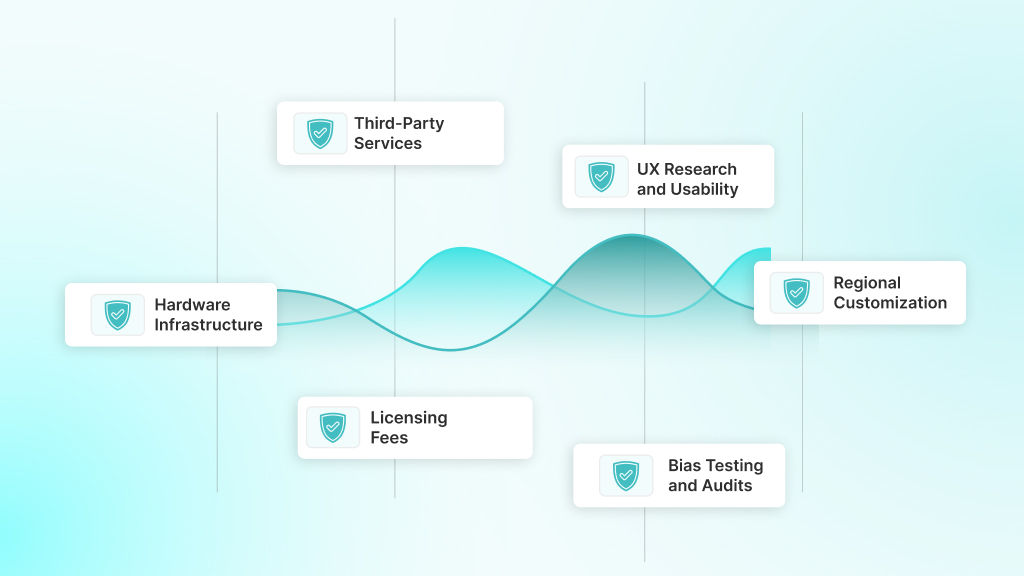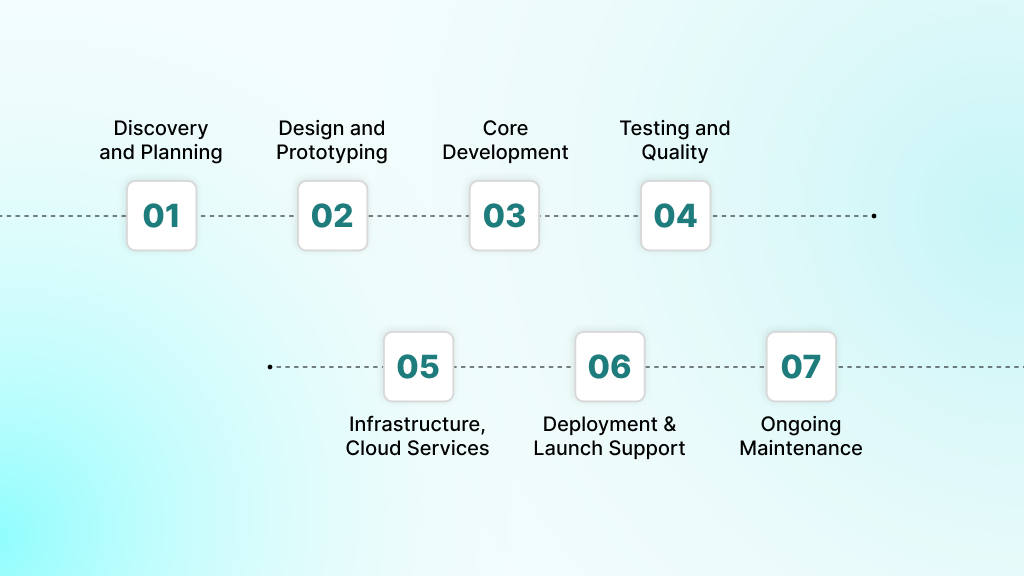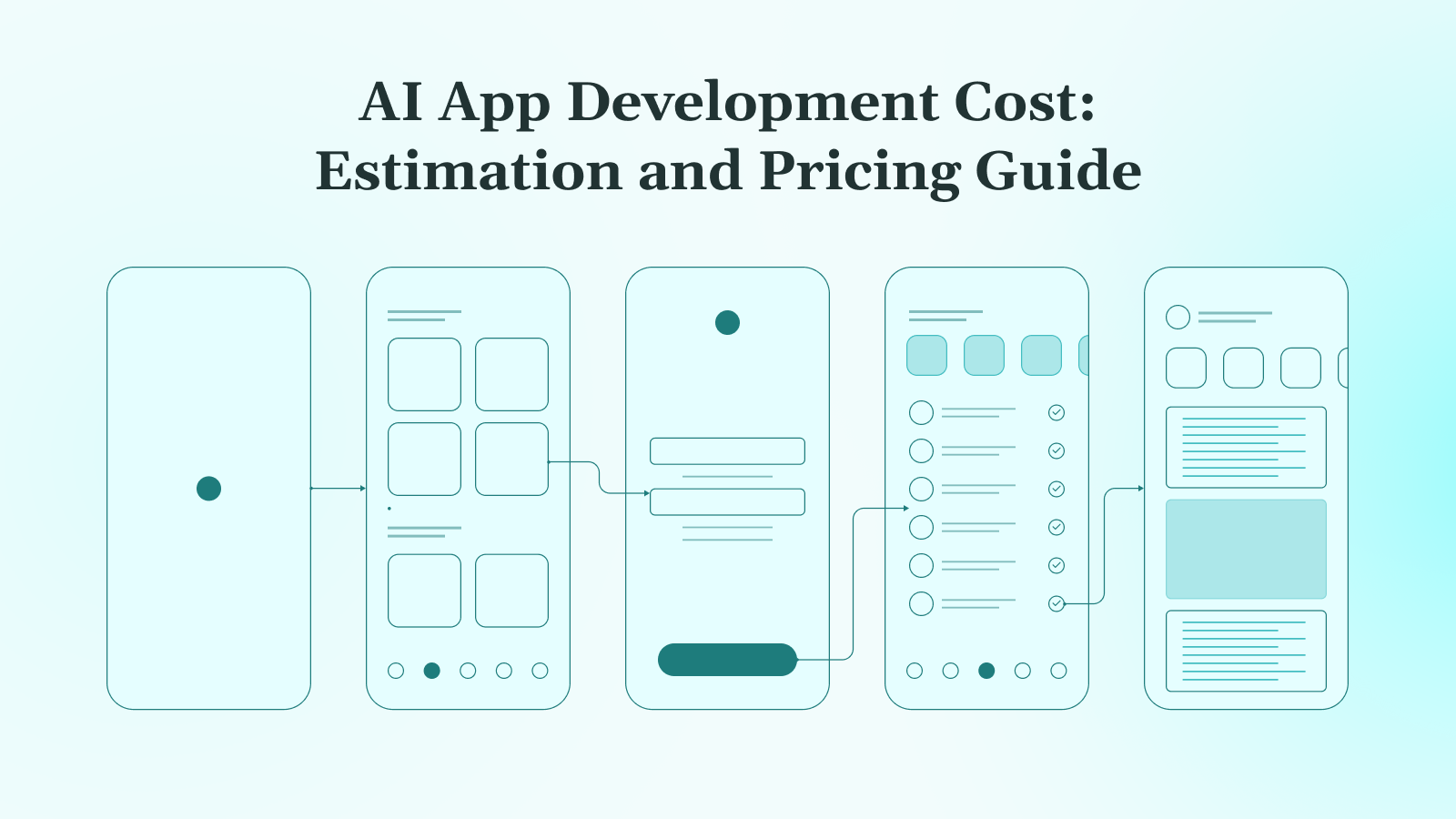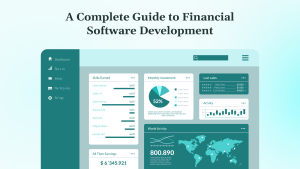Artificial intelligence is evolving from innovation to an industry standard, powering applications across various sectors, including healthcare and finance. In 2025, the global AI market is projected to surpass $244 billion, fueled by organizations racing to gain a competitive advantage with intelligent solutions.
For business leaders, CTOs, and product managers, understanding what truly drives the cost to build an AI application is not just useful; it is essential for delivering results while managing risk.
This guide breaks down the real-world factors, from system complexity to technology choices, that will define your AI app development budget in 2025. From building a simple AI-powered chatbot to developing a complex custom solution, knowing these cost variables upfront sets you up for scalable success.
Key Takeaways
- AI app development costs in 2025 vary widely based on project scope.
- Simple rule-based tools cost significantly less than advanced platforms with custom models and integrations.
- Major cost drivers include complexity, feature set, data quality, technology stack, and development team location.
- Data preparation, including cleaning, labeling, and securing, can substantially increase budget requirements.
- Starting with clear goals and a focused MVP helps avoid scope creep and control costs.
- Post-launch costs, including maintenance, retraining, and compliance, amount to 15 to 20 percent annually.
- Planning for the full lifecycle is essential to building a scalable, cost-effective AI solution.
Factors Influencing AI App Development Costs

Several key factors influence the overall cost of AI app development. Understanding these elements enables more accurate budgeting and aligns software features with business value.
1. Project Complexity and Scope
The complexity and scope of your AI project directly influence development time and costs. Understanding how features and system requirements scale helps set realistic budgets and timelines.
- Simple AI apps (e.g., chatbots) cost $10,000 to $50,000 and take 2 to 3 months, while advanced features like NLP or predictive analytics raise costs to $50,000 to $150,000 with 4 to 6 months of development. Complex projects with custom models or computer vision start at $150,000 and can exceed $500,000, lasting over a year.
- Expanding the scope by adding features, integrations, or user roles increases development time, testing, and maintenance, resulting in higher costs and longer timelines.
2. Model Training, Testing, and Validation Costs
Training and validating AI models take a lot of resources and affect your budget. Here are the main points:
- Compute Resources: Training requires powerful computers, such as GPU servers or cloud services. Depending on the data size and model, this can cost between $15,000 and $120,000.
- Tuning and Testing: Making the model better involves many rounds of adjustment and testing. This uses developers’ time and extra computing power, adding to costs.
- Validation and Rules: Checking the model’s accuracy and following industry rules, especially in fields like healthcare and finance, adds necessary costs.
- Skilled Team: Experts like machine learning engineers, data scientists, and testers work to ensure the model works well and meets standards, which also costs money.
3. Data Collection and Preparation
The quality and volume of data required play a crucial role in determining AI development costs, as sourcing and preparing data can be resource-intensive and impact the overall budget.
- The amount, quality, and availability of data strongly affect costs.
- Structured, existing data is more affordable to use than proprietary or raw data that requires heavy cleaning or labeling.
- Data sourcing and preparation can range from $5,000 to $100,000+; monthly upkeep may reach $20,000 in data-intensive sectors.
4. Customization Level
AI development costs rise with customization, as ready-made solutions are cheaper than fully tailored models for specific needs.
- Off-the-shelf AI solutions or APIs cost less than fully custom, domain-specific AI models.
- Extensive feature development or unique UI/UX needs raise budget requirements.
- Custom AI for proprietary processes or regulated industries further increases costs. DEVtrust assists organizations in balancing customization with proven frameworks to control expenses while delivering tailored results.
5. Development Team Size and Expertise
The makeup and capabilities of your AI development team have a significant influence on both overall project costs and delivery timelines. Understanding how team size, regional rates, and specialist expertise affect your budget is essential for smart planning and successful outcomes.
- Team Size: Small projects usually need 3 to 5 members, medium projects 6 to 10, and large projects 10 or more, covering roles like data scientists, ML engineers, and domain experts.
- Location & Rates: Hourly rates vary by region, with North America and Western Europe ranging between $80 to $250+, while Asia and Eastern Europe range from $20 to $60.
| Region | Approximate Hourly Rate (USD) |
| North America | $80 to $250+ |
| Western Europe | $80 to $200 |
| Australia & New Zealand | $70 to $150 |
| Eastern Europe | $20 to $60 |
| Asia (India, SE Asia) | $20 to $60 |
Expertise: Senior specialists can command $200 or more per hour, but their experience reduces risks and ensures quality.
Balancing these factors helps control costs while meeting project goals.
6. Integration and Maintenance Requirements
Ongoing integration and maintenance are key to keeping your AI app effective and cost-efficient over time.
- Connecting the AI app with existing enterprise systems or external data sources adds extra complexity and budgetary needs.
- Ongoing maintenance, model updates, troubleshooting, and compliance checks contribute to long-term costs. Annual support may account for 15 to 20% of initial build expenses.
Careful planning around these factors ensures that the final investment aligns with both business objectives and the project’s scale. Each organization should balance desired features, performance, and budget constraints to achieve the most effective AI solution.
7. Technology Stack and Tools Used
The tools and technology stack you choose play a major role in shaping AI project costs, influencing everything from initial build to long-term maintenance.
- Custom frameworks (e.g., deep learning with custom layers) cost more than building with standard libraries.
- Third-party APIs (Stripe, Plaid, Twilio, OpenAI, Google APIs) may reduce initial build time but add licensing and usage fees over time.
- Cloud platforms like AWS, Azure, or Google Cloud are essential for real-time data, scalability, and compliance. Each platform has its own pricing. Cloud architecture planning and DevOps setups also introduce upfront costs.
- Included tools: Node.js, React, Django, Docker, GraphQL add distinct engineering demands. Using modern, flexible stacks (as recommended at DEVtrust) can reduce long-term maintenance.
Comparison Table:
| Stack/Tooling | Upfront Cost Impact | Maintenance Cost Impact |
| Custom Build | High | High |
| Off-the-Shelf APIs | Moderate | Ongoing fees |
| Open Source Stacks | Moderate | Low to Moderate |
| Proprietary Solutions | High | High |
Tool and stack selection should align with performance, security, and long-term planning..
Experience Matters
- Experienced teams reduce risks and technical debt via efficient development and early detection of potential issues.
- Junior or mid-level teams manage standard builds at lower rates but may require more oversight on complex AI solutions.
- Prior experience with AI projects is critical for managing data challenges, regulatory constraints, and model validation.
Essential Skills Required
- Strong programming skills (Python, R, Java, or Scala).
- Proficiency in machine learning frameworks (TensorFlow, PyTorch).
- Data engineering expertise including SQL, NoSQL, Spark, and Hadoop.
- Cloud platform experience (AWS, Azure, Google Cloud).
- Domain knowledge for aligning AI with business goals.
- Communication and problem-solving skills across technical and business domains
Careful selection of team structure, skill sets, and location ensures cost efficiency without sacrificing AI app quality or delivery speed.
Hidden and Overlooked Costs in AI App Development

Beyond core coding and design, several hidden costs often escape early budgets but can significantly impact your AI app development cost and long-term ROI. Recognizing and planning for these factors ensures smoother delivery and fewer surprises:
- Hardware Infrastructure: Powerful hardware like GPUs or TPUs is essential for training and deploying AI models, especially deep learning ones. Renting or purchasing such resources, or cloud computing fees for these, can be a substantial ongoing expense.
- Third-Party Services and APIs: Utilizing external AI services and APIs accelerates development but often involves usage-based fees. As your app scales, these can add up, affecting both upfront and operational budgets.
- Licensing Fees: Many AI development tools and enterprise platforms charge monthly or annual license fees. These costs require inclusion in your budget, particularly for advanced features or commercial use.
- UX Research and Usability Testing: Ensuring your AI app is user-friendly and effective demands dedicated testing and refinement. Investing in user experience research helps avoid costly redesigns after launch.
- Bias Testing and Ethical Audits: Regular checks for fairness and bias are critical to avoid reputational damage and legal risks. Specialized audits may be needed, adding to your costs but safeguarding your brand integrity.
- Localization and Regional Customization: Adapting your app for multiple languages, cultures, or regulatory environments involves extra development effort, which is vital if targeting international or diverse markets.
Step-by-Step: Stages of AI App Development

Understanding the key phases of AI app development helps ensure a successful and cost-effective project. Each stage, from upfront planning to ongoing maintenance, plays a vital role in turning an idea into a robust, market-ready solution.
1. Discovery and Planning
The process begins with discovery and planning, where the team defines the app’s purpose and identifies the target audience. It is crucial to clarify the specific business problems the AI solution will address. During this stage, competitors and market trends are analyzed to position the product better. The project scope, main features, timeline, and rough budget are also established. Clear planning reduces risks and lays the groundwork for the entire development lifecycle.
2. Design and Prototyping
After planning, designing, and prototyping, turn ideas into visual concepts. Designers create wireframes and mockups that illustrate the user interface and how users will navigate the app. Building an interactive prototype enables early user testing and the collection of feedback. This phase helps identify usability issues before the costly development phase starts and ensures alignment on look and feel.
3. Core Development & AI Model Training
With the design approved, core development begins. Developers write the front-end code visible to users and build back-end systems to support app functionality. Simultaneously, AI specialists develop or customize machine learning models to perform necessary tasks. Integration between the AI models, databases, and external systems is established. This stage transforms designs into a working application.
4. Testing and Quality Assurance
Once the app is built, comprehensive testing ensures it meets functional, performance, and security standards. The team checks AI model accuracy, runs usability tests across devices, and identifies any bugs or faults. Fixing issues before launch prevents user dissatisfaction and costly post-release patches. Quality assurance guarantees the app’s stability and reliability.
5. Infrastructure, Cloud Services, and Deployment
Reliable cloud infrastructure ensures your AI app runs smoothly and stays available 24/7. Initial setup costs typically range from $5,000 to $25,000 and cover provisioning, database setup, and integration pipelines. Ongoing monthly expenses vary between $500 and $3,000 or more for mid-sized apps, with higher costs expected for real-time inference or high-availability configurations.
It’s important to plan early for scaling, including additional users or increased data streams, especially for critical applications such as telemedicine or real-time trading. Proper infrastructure planning helps prevent downtime and ensures your app’s data security throughout its lifecycle.
6. Deployment and Post-Launch Support
After passing tests, the AI app is deployed to production, whether on cloud infrastructure, app stores, or web platforms. Developers monitor real-time app performance, swiftly resolve emerging issues, and gather user feedback. Early support is critical for smooth adoption and maintaining a positive user experience.
7. Ongoing Maintenance and Improvements
Post-launch, your AI app needs ongoing maintenance, including bug fixes, security updates, and retraining models to handle new data trends. New features may be added based on user feedback and business goals. Regular compliance updates keep the app lawful and competitive.
Controlling costs early by prioritizing features, piloting MVPs, and avoiding scope creep helps manage long-term expenses.
| Stage | Approximate Cost Range | Notes |
| Discovery and Planning | $5,000 to $15,000 | ~5 to 10% of the total project budget. |
| Design and Prototyping | $10,000 to $30,000 | ~10 to 15% of development costs. |
| Core Development & AI Model Training | $50,000 to $200,000+ | 40 to 50%+ of project costs vary widely with AI complexity. |
| Testing and Quality Assurance | $15,000 to $50,000 | ~15 to 20% of the project budget. |
| Infrastructure and Deployment | $5,000 to $25,000 initial setup + $500 to $3,000+/month ongoing. | Scale and complexity affect costs. |
| Deployment and Post-Launch Support | $5,000 to $20,000 | 5 to 10% of the project budget. |
| Ongoing Maintenance and Improvements | 15 to 20% of development cost annually or $2,000 to $10,000/month. | Includes retraining, updates, and new features. |
Licensing, Compliance, and Support
AI deployment necessitates careful consideration of legal and commercial implications.
- Licensing costs: Third-party tools (AI APIs, data providers, cloud platforms) involve setup, monthly, or per-use fees.
- Compliance: Apps serving healthcare, finance, or education require certifications (HIPAA, PCI DSS, FERPA, GDPR). Compliance mandates add to initial and recurring costs.
- Hidden support expenses: Regulated sectors are required to undergo annual audits, maintain documentation, and ensure emergency response readiness.
- Example: HealthTech and FinTech products may allocate 10 to 20% of their budget to compliance and support.
Failing to plan for these areas can result in costly fixes and regulatory penalties.
Case Study: Financial Chatbot Powered by DEVtrust
Financial Chatbot is an AI platform that delivers real-time investment insights to help investors make smarter decisions quickly.
Challenges
Integrating multiple real-time financial data sources was a complex task. The platform needed an engaging and intuitive user experience. It also required advanced tools for stock analysis and crypto updates.
Solutions
DEVtrust integrated leading APIs, including OpenAI and TradingView. We developed an AI chatbot powered by OpenAI to answer stock queries and predictions. The user interface was designed to present insights. Portfolio risk analytics were added for better investment decisions.
Impact
The platform improved decision-making speed by 50%. User search time for information dropped by 40%. Investment optimization increased by 50%. Crypto prices and news updates were seamlessly integrated.
DEVtrust offers expert AI development to turn your ideas into impactful solutions. Contact us today for a personalized consultation.
Conclusion
Accurately estimating the cost of your AI app development is vital for making informed decisions, managing risk, and planning for long-term growth. The right balance of planning, scope, and technical execution can significantly lower expenses while increasing ROI.
By partnering with DEVtrust, you gain more than just development expertise; you get:
- Tailor-made AI/ML solutions aligned perfectly with your business goals.
- Full-cycle development and post-launch support, ensuring reliability at every stage.
Want to bring your AI idea to life, on time and within budget?
Book a free consultation with DEVtrust and get a custom roadmap for your AI app today.
AI App Development Cost: Estimation and Pricing Guide
Unravel AI app development cost factors. From project complexity to team expertise, get budgeting insights and minimize expenses. Get started now!
Contact Us


